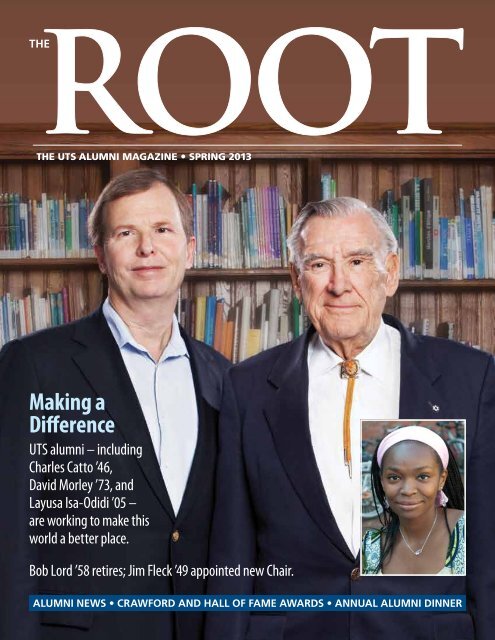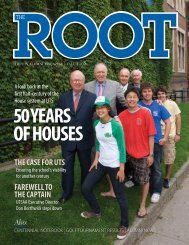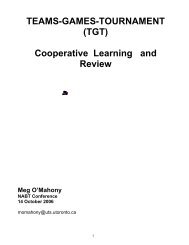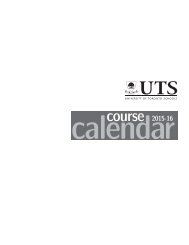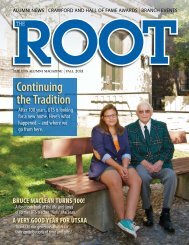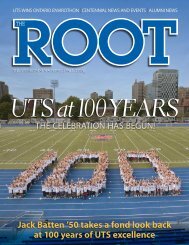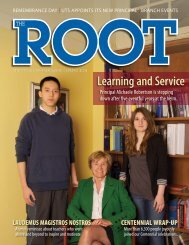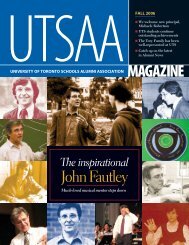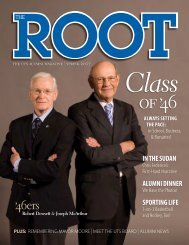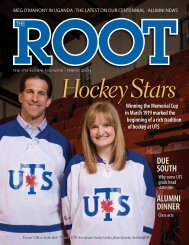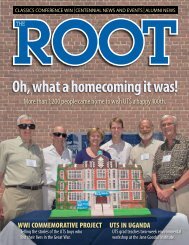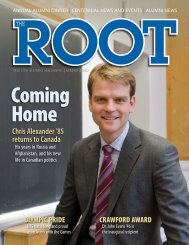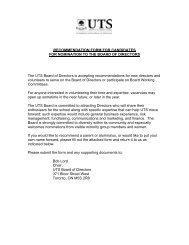Spring 2013 - University of Toronto Schools
Spring 2013 - University of Toronto Schools
Spring 2013 - University of Toronto Schools
Create successful ePaper yourself
Turn your PDF publications into a flip-book with our unique Google optimized e-Paper software.
RootTheThe UTS ALUMNI MAGAZINE • <strong>Spring</strong> <strong>2013</strong>Making aDifferenceUTS alumni – includingCharles Catto ’46,David Morley ’73, andLayusa Isa-Odidi ’05 –are working to make thisworld a better place.Bob Lord ’58 retires; Jim Fleck ’49 appointed new Chair.Alumni News • Crawford and Hall <strong>of</strong> Fame Awards • Annual Alumni dinner
Contents 22Mark Your Calendars 2Bits & Pieces 4President’s Report 8Principal’s Report 9UTS Board Report 10Advancement Report 11Crawford Award and Hall <strong>of</strong> Fame 21Annual Alumni Dinner 22Making a DifferenceMany UTS alumni are working with Not-for-Pr<strong>of</strong>it andNon-Governmental Organizations on local, national, andglobal stages to make this world a better place. Here area few <strong>of</strong> their stories – including interviews with CharlesCatto ’46, David Morley ’73, and Layusa Isa-Odidi ’05. ........12Alumni NewsVictor YeungAll the latest in the lives <strong>of</strong> your classmates, includingIn Memoriam and tributes to the lives <strong>of</strong> five distinguishedalumni. .............................................24Above: Reception entertainment at the Annual AlumniDinner was provided by the UTS Jazz Trio: musiciansThomas Broadley, Trevor Clokie, and Alexander Levy withvocalist Lucinda Qu (all Class <strong>of</strong> <strong>2013</strong>).On the cover: Charles Catto ’46 and David Morley ’73;photograph: Jamie Day Fleck. (Inset: Layusa Isa-Odidi ’05)Our thanks to this issue’s contributors:Derek Bate ’44, Don Borthwick ’54, Ted Cross ’43, NinaCoutinho ’04, Martha Drake, Rosemary Evans, ChristopherFederico ’91, Jim Fleck ’49, Meg O’Mahony, CharliePullen, Jane Rimmer, Diana Shepherd ’80, John Wilkinson’78, and Carole Zamroutian.Special thanks to our new pro<strong>of</strong>reader: retired UTSprincipal Don GutteridgeLooking Back background: © iStockphoto.com/PeterZeleiEditor: Diana Shepherd ’80Design: PageWave Graphics Inc.Printed in Canada by Colour Systems Inc.UNIVERSITY OF TORONTO SCHOOLSVELUT ARBORITA RAMUS<strong>University</strong> <strong>of</strong> <strong>Toronto</strong> <strong>Schools</strong> Alumni Association371 Bloor Street West, Room 121, <strong>Toronto</strong>, Ontario M5S 2R7Phone: 416-978-3919 Fax: 416-971-2354E-mail: alumni@utschools.ca Web: www.utschools.ca/alumniPublished spring and fall, The Root is available to all alumni, parents and friends <strong>of</strong> UTS.Contact us at the above addresses to receive a copy or to change your address.The issue is also available at: www.utschools.ca/root
Bits & PiecesA Compendium <strong>of</strong> Noteworthy UTS TidbitsBob Lord Steps Downafter 14 YearsWords cannot do justice to thecontributions that Bob Lord ’58 hasmade to UTS: he exemplifies thevalues <strong>of</strong> the school through hiscommitment to scholarship, athletics,volunteerism, respect, and leadership.As Chair <strong>of</strong> the Development SteeringCommittee (1999); Vice-Chair, BuildingOpportunities Campaign (2000/2001);Chair, Interim UTS Board (2001-2004);and Chair, UTS Board <strong>of</strong> Directors (2004-13), Bob’s contributions have been trulyoutstanding. He will be rememberedfor successfully leading UTS throughthe intricate and challenging transitionfrom a department within OISE to anaffiliate <strong>of</strong> the <strong>University</strong> <strong>of</strong> <strong>Toronto</strong> andan independent legal entity. Throughouthis tenure, Bob has provided remarkablestewardship as UTS achieved agovernance structure, financialindependence, a strategic plan, and theresultant stability to solidify our future.Bob <strong>of</strong>ten harkens back to the<strong>of</strong>fice visit Don Borthwick ’54 andretired principal, Stan Pearl, made in1999 to request his acceptance <strong>of</strong> theDevelopment Committee Chair – a timewhen UTS was attempting to migratefrom its “Preserving the Opportunity”bursary campaign success to an ongoingDevelopment/Advancement operation.Bob Lord, with his wife Patricia, and granddaughter Zoë at UTS this winter, in front <strong>of</strong> a displaychronicling Bob’s accomplishments.“Bob never forgets to remind Stan andme <strong>of</strong> this time,” says Don. “Little did anyone <strong>of</strong> us know the journey ahead, butwe certainly made the right choice.”As a UTS student, Bob played bothfootball and hockey; during his earlyyears, he could always be countedon to be in the stands for the hockey“Firsts” games. His classmates rememberhim for his sense <strong>of</strong> humour, and inparticular his hilarious imitations. Upongraduation from UTS, he received thesecond George and Elizabeth RutherfordScholarship at Victoria College.Through his years <strong>of</strong> volunteerinvolvement at the school, Bob wasable to establish positive relationshipswith alumni, parents, students, staff,and friends <strong>of</strong> the school. Don notedthat one <strong>of</strong> Bob’s great strengths washis ability to coalesce many divergingopinions and move the issue ahead toa satisfactory conclusion. He has spentcountless hours as a UTS advocateand advisor, and this passion for UTShas influenced many others to supportthe school.Bob has earned much success andrespect in his pr<strong>of</strong>essional life: as aChartered Accountant who served as theVice-Chair <strong>of</strong> Ernst & Young, as the Chair<strong>of</strong> the Canadian Institute <strong>of</strong> CharteredAccountants and the Royal Life SavingSociety <strong>of</strong> Canada, and as a Director<strong>of</strong> the YMCA <strong>of</strong> Greater <strong>Toronto</strong>. Bobalso served on the boards <strong>of</strong> severalpublic and private corporations andhas participated in many advancementefforts for the <strong>University</strong> <strong>of</strong> <strong>Toronto</strong> andhis alma mater, Victoria <strong>University</strong>.In all spheres, Bob is recognized andappreciated as an advisor and for hissocially responsible global citizenship –the core <strong>of</strong> the UTS vision today. Theseattributes were recognized in 2010 whenhe was the second recipient <strong>of</strong> the HenryJob Crawford award. n4 THE ROOT • <strong>Spring</strong> <strong>2013</strong>
Paul Moore with Principal Rosemary Evans and UTS teacher (and veteran) Christopher Federico ’91.Coming Face-to-Facewith the PastMemory, we know, is an extremelypersonal thing. So in some respects it is abit peculiar to put 700 students, teachers,and alumni all together in one roomevery Remembrance Day and ask themto collectively remember somethingthat happened to other people long agoand far away. Of course 90 years ago,when Canadians first began observingRemembrance Day, it was verydifferent. The Great War loomed largein everyone’s memory, and thosewho gathered did so to acknowledgeand reflect upon a deeply personalyet shared experience. To ensure thisexperience was never forgotten, theybuilt us a time machine <strong>of</strong> sorts. Oncethe state <strong>of</strong> the art in time travel, thismachine may seem a bit <strong>of</strong> a jalopy now,cobbled together as it is out <strong>of</strong> bronzeplaques and bugle music and snippets<strong>of</strong> poetry. Although it still puts out alot <strong>of</strong> power, we may need to tinker alittle with the mechanics if it is to getthe 21st-century traveller to his or herintended destination.That’s a problem, <strong>of</strong> course, becausemuch as we might wish to partition <strong>of</strong>fthe unpleasant events <strong>of</strong> the past, weknow that outside <strong>of</strong> school one can’tjust drop history if one doesn’t like theresults. So to remember thoughtfully, wemust do a better job <strong>of</strong> unravelling thatball <strong>of</strong> “wibbly-wobbly-timey-wimeystuff” [Ed. quoted from the long-runningBritish TV series, Doctor Who] we callhistory. What if, for example, instead <strong>of</strong>merely filing past those bronze plaques,we could stop and have a conversationwith just one <strong>of</strong> those veterans? Overthe years, we have tried to do just thatby including the voice <strong>of</strong> a UTS veteranin our program. In 2012, we wereprivileged to have John McIntyre ’37in attendance. He shared with us hispersonal recollections <strong>of</strong> WW2 via a prerecordedvideo interview, reminding usthat the conflicts we know only throughbooks and films were very real to ourpredecessors at UTS.Victor YeungAt the ceremony, UTS recognizedone <strong>of</strong> our most experienced timetravellers– one who has shared hisjourneys with the school for nearly25 years and who, despite having<strong>of</strong>ficially retired long ago, remainsdedicated to illuminating UTS history.Thanks to the leadership and inspirationprovided by Dr. Paul Moore, the onlineCommemoration Project allows us tocome face-to-face with the UTS veterans<strong>of</strong> WW1 – and we shall soon be able todo the same for our veterans <strong>of</strong> WW2.(To see the Commemoration Projectgo to www.utschools.ca and select the“WW1” button.)As the global wars <strong>of</strong> the past recedefurther from our personal memory, itwill demand a greater effort each yearto ensure that the ceremony remainsmeaningful to new generations <strong>of</strong>faculty, staff, students, and alumni;UTS is extremely grateful to all thoseto work each year to continue to makeit so. n– Christopher Federico ’91, UTS teacherTHE UTS ALUMNI MAGAZINE5
UN COP 18From Here to Qatar (and VirtuallyEverywhere Else)In November, ten M4-S6 (Grades 9-12)students participated in the UN ClimateChange Conference: COP18 Under-18 National Virtual Conferencing andSummit. The UTS team was selected asone <strong>of</strong> only six school teams from acrossCanada (NW Territories, Quebec, BC,Alberta, Ontario, and Manitoba) alongwith schools in India and Thailand.The project, masterminded by TerryGodwaldt, the Director <strong>of</strong> Programmingat the Alberta Virtual Classroom Centrefor Global Education, made brilliantuse <strong>of</strong> technology. Participants wereable to interact and dialogue with eachother via video-conferencing and Skypeconversations, as well as discussionblogs. The debate addressed the moralrole <strong>of</strong> developed nations in supportingdeveloping nations while also decreasingtheir own carbon footprints.The students spent six weekspreparing intensively for the program,which included a Virtual TownHall convened across Canada onNovember 14. For UTS, the day beganwith a workshop facilitated by AzraShivji ’08, who is currently studying fora Masters in Global Health at McMaster.Azra – who attended COP13 in Bali,Indonesia, courtesy <strong>of</strong> the BritishCouncil – shared insights on the politicaland social processes <strong>of</strong> UN meetings.The day also included virtual keynotespeeches from Canadian Liberal SenatorGrant Mitchell and Dr. Eric Newell,Chancellor <strong>of</strong> the <strong>University</strong> <strong>of</strong> Alberta.This full-day national video-conferencesummit allowed these students tocollaborate in the writing <strong>of</strong> a WhitePaper on Climate Change on behalf <strong>of</strong>the youth <strong>of</strong> Canada. The paper waslater presented to Senator Mitchell andthen taken to the United Nations ClimateChange Conference in Doha, Qatar bya youth delegation that presented it onbehalf <strong>of</strong> the youth <strong>of</strong> Canada. n– Meg O’Mahony, UTS teacherStudents in the UTS library participating in theCOP-18 video-conference.6 THE ROOT • <strong>Spring</strong> <strong>2013</strong>
Interdisciplinary Arts DayJim McGrath is a musician whodraws on his understanding <strong>of</strong> film,psychology, and storytelling in his workas a film composer. Elysha Poirier isa visual artist whose work is createdlive in a performance choreographedin collaboration with dancersand musicians.In order to help UTS studentsdevelop into the life-long “learners,communicators [and] creative artists”that the UTS Mission Statementcelebrates, they need to have anauthentic understanding <strong>of</strong> howcontemporary artists, like McGrathand Poirier, create their work – andhow many contemporary artists seekproductive connections with a variety<strong>of</strong> disciplines. With this goal in mind,this year the Expressive Arts Departmentlaunched A3+ Day: “All Three” UTS artsdisciplines (music, drama, and visualarts) “Plus” connections beyond.<strong>Schools</strong> typically “silo” the arts: a focusthat allows for more time to developdiscipline-specific skills. However,by compartmentalizing, schools riskfragmenting vision and curtailingcreativity. A3+ Day sought to explorethe following question: “What creativepotential exists in the <strong>of</strong>ten-overlookedspaces between the boundaries <strong>of</strong>artistic disciplines?”The day focused on a series <strong>of</strong>performances and presentations froma slate <strong>of</strong> contemporary artists whoseek out these overlooked spaces forinspiration and innovation. Along withMcGrath and Poirier, students metwith: dancer/choreographer AndreaNann, who is the Artistic Director <strong>of</strong>Dreamwalker Dance; lighting designerDavid Duclos; dancer Brendan Wyatt;short-filmmaker Randall Okita; andinteractive installation artists ThomSokoloski and Jenny-Anne McCowan.F2 (Grade 8) students were selectedto participate since they are uniquelysituated to take advantage <strong>of</strong> thisexperience in preparation for therelatively wide-ranging arts choicesthe Ontario curriculum allows them inGrades 9 and 10. So, while an F2 studentmight consider herself to be a cellist,an actor, or a photographer, A3+ Daysought to encourage how experienceswith any art form can serve as a startingplace for growth – growth into the otherarts and perhaps beyond, into otheracademic and personal interests. n– Charlie Pullen, UTS teacherTop: F2 students investigating sculptural shapes in a movement class during A3+ Day.Below: Dancers Andrea Nann and Brendan Wyatt perform on the UTS stage.THE UTS ALUMNI MAGAZINE7
President’s Report<strong>Spring</strong> into Action!<strong>Spring</strong> represents renewal: a time to launch into a new phase, into new opportunities.John Wilkinson, ’78President, UTSAAAt UTS, spring is an exciting time as teachersand students realize all they have accomplishedto date during the school year – and build ontheir experiences and successes as they enterthe “home stretch”. For your Alumni Association,spring <strong>2013</strong> is a time to build on our rejuvenatedbase so as to serve you and our alma mater witheven more vigour and ideas than ever. Here aresome examples:• UTSAA is reaching out. Through meetings,presentations, and (coming soon) surveys,we’re reaching out to UTS stakeholders (alumni,current students, faculty, parents, the UTSBoard, and the UTS Foundation) so that weunderstand their mandates and priorities –and so that we can continue to maintain theAssociation and to innovate in a manner that isresponsive to all those groups.• UTSAA is organizing. From the introduction<strong>of</strong> a novel way to distribute funds fromthe H. Donald Borthwick Student Fund; toorganizing traditional events (the basketballtournament, the Alumni hockey game, andthe golf tournament to name the more athleticendeavours); to brainstorming new events tocater to the changing Alumni pr<strong>of</strong>ile.<strong>Spring</strong> <strong>2013</strong> is a time to build on ourrejuvenated base so as to serveyou and our alma mater with evenmore vigour and ideas than ever.• UTSAA is welcoming. There are numerouscommittees on which you can participate andmany events in which you can participate. Whynot think up a new Alumni activity for UTSAA’sconsideration? You’ll get so much more out <strong>of</strong>your involvement than you could imagine.But how do you get involved? There are manyways that you can connect with your UTSAA andUTS itself, including:• Arrange a visit to the school. Our energeticand engaging Principal Rosemary Evans and herstaff will welcome you with tales <strong>of</strong> the lateststudent-led success or faculty-inspired initiative.• Place a call to the UTS Office <strong>of</strong>Advancement (416-946-0097). Our enthusiasticand efficient Executive Director Martha Drakewill explain all that the UTSAA can do for youand all that you can do for the School!• Surf the UTSAA’s section <strong>of</strong> the UTSwebsite (www.utschools.ca/alumni) whereyou can peruse recent events and upcomingopportunities, honour your favourite alumni bynominating them as Notable Alumni, or finallyget your friends together to play some ball byrenting gym space. Please check out the siteand see all it has to <strong>of</strong>fer!• Organize an event to reconnect withclassmates. The Office <strong>of</strong> Advancement willhelp! There is no need to wait for a specialyear – just use the phone, email or social mediaand make it happen. For example, recentlydozens <strong>of</strong> local alumni from a ’70s classgathered at a <strong>Toronto</strong> home for no reason otherthan to reconnect – and from all accounts, theinformal event was a great success.From attending a UTSAA event; to volunteeringand making a School event even better; toarranging a get-together for a few friends, a schoolteam, or a whole class – I encourage you to springinto action so that you are part <strong>of</strong> UTS’ future byconnecting again with the present version <strong>of</strong> yourpast. Carpe diem! n8 THE ROOT • <strong>Spring</strong> <strong>2013</strong>
Principal’s ReportEquity and DiversityUTS students learn to appreciate and respect multiple perspectives.This issue <strong>of</strong> The Root focuses on alumni whohave made a significant difference to othersthrough their commitment to equity and socialjustice. At UTS, our students consistently impressme with their dedication to righting wrongs. Itis impossible to capture the full extent <strong>of</strong> thatcommitment, but a story about one student willperhaps prove illustrative <strong>of</strong> the thoughtfulness,empathy, and creativity evident in so many <strong>of</strong>our students.Last summer, one <strong>of</strong> our F1 (Grade 7) studentsinvited me to a lemonade stand he and hisbrother had set up to raise funds for War Child,a Canadian NGO. Kieran and Alastair also madebookmarks, T-shirts, and fridge magnets; overthree days, they raised $3,021. In September, theboys were presented with War Child’s Fundraiser<strong>of</strong> the Year Award. In speaking to Kieran, itwas clear to me that he was motivated by hiscommitment to improving the lot <strong>of</strong> childrenwhose lives have been devastated by war.Social responsibility as exemplified by Kieranis articulated in the UTS Vision statement.Furthermore, our Strategic Plan states that:“UTS recognizes its responsibility to students,employees and families to sustain the primacy <strong>of</strong>equity, diversity and social justice”. It is importantto recognize the responsibilities that accompanythis direction, which guides a number <strong>of</strong> initiativesat the school.Our school welcomes – in fact actively recruits –a diverse student body, representing a wide range<strong>of</strong> cultural, racial, linguistic, and faith traditions,along with a variety <strong>of</strong> personal interests andpassions. The result is a rich community wherestudents learn to respect multiple perspectives,to question their assumptions, test their values,and appreciate others. Our students are admittedon the basis <strong>of</strong> merit, and the school continuesto strive to provide needs-based funding to thosewho gain admittance and qualify for financialsupport. To complement these efforts, we areimplementing a supplementary bursary programto provide these students with additional funds toensure that they can participate fully in ourcurricular and co-curricular program. We believethis will result in equity <strong>of</strong> access to the fullUTS experience.We are building on our current EquityFramework to develop an Equity Policy. Weare providing pr<strong>of</strong>essional learning to all staffto enhance their skills and understanding inthis complex domain; and special trainingand support to students to allow them bothto recognize inequities that limit access andto build an inclusive school community. Inaddition, we are examining our curriculum toensure that all students can see themselves inour program – including their unique personalattributes related to such characteristics asethnicity, gender, sexual orientation, and class.We also want to ensure that multiple view-pointsand opportunities for critical and creative thinkingare actively included in the UTS classroom.A commitment to diversity and equity <strong>of</strong>tenresults in a drive to take action to enhancesocial justice. Like Kieran, many UTS studentsand staff extend their learning beyond theclassroom – becoming advocates for changeand working in partnership with others to makea difference. This year has seen many suchinitiatives related to climate change, transit reform,homelessness, and food scarcity to name onlya few. A quick review <strong>of</strong> our Facebook page(www.facebook.com/utschools), or the “News andEvents“ pages on our website (www.utschools.ca), provides many examples <strong>of</strong> the vibrancy andrichness <strong>of</strong> the UTS experience and, in particular,the commitment to equity and social justice. nRosemary EvansPrincipal, UTSOur school welcomes – in fact activelyrecruits – a diverse student body.THE UTS ALUMNI MAGAZINE9
UTS Board ReportLeadership and AccessibilityThe Board intends to support UTS in its role as an exemplary school in the province.Jim Fleck ’49Board Chair, UTSJamie Day FleckUTS Board <strong>of</strong> DirectorsThis article represents my first opportunity asChair <strong>of</strong> the UTS Board <strong>of</strong> Directors to outlinethe current priorities facing the Board. Theseinitiatives are all aimed at securing the future <strong>of</strong>the school to ensure that UTS can continue tonurture academically able students to flourish andto make significant contributions on the local,national, and global stages.When I attended UTS in the late 1940s,tuition was $50 per year. Funded by the OntarioGovernment, UTS acted as a model school withinthe Ontario College <strong>of</strong> Education. Generallyspeaking, the cost <strong>of</strong> tuition was not an issuefor most students; the major factors limitingaccess were knowledge <strong>of</strong> the school and thelocal transportation system. Like many <strong>of</strong> today’sstudents, I commuted, travelling almost threehours daily to and from my home in Oshawa;within reason, distance and travel time do notcreate insurmountable barriers to attendance.The board intends to support UTS in its roleas an exemplary school in the province – ifnot beyond – and to help make the schoolmore accessible. These two goals are <strong>of</strong> coursecomplicated by the challenges <strong>of</strong> securing a sitefor the future.Our new Access Committee is investigatingways to increase admission <strong>of</strong> students fromacross the socio-economic spectrum – exploringavenues that will supplement the bursary funds.Chair: Jim Fleck ’49Vice Chair: John Duffy ’81, ParentSecretary: F. David Rounthwaite ’65Treasurer: Andrew Dalglish, ParentDirectors:David Allan ’78Jim Gracie, ParentAndre Hidi ’77Michelle Hull, ParentPrabhat Jha, ParentPeter Neilson ‘71Nasir Noormohamed, ParentSusan Opler ’79, ParentDonald Schmitt ’70www.utschools.ca/discoveruts/utsboardAccess is critical to differentiating UTS from otherprivate schools and, more importantly, to shapingthe UTS students <strong>of</strong> the future. Appreciation <strong>of</strong>diversity – and the reality <strong>of</strong> living and learningwithin a diverse community that challengesprivilege – must continue to shape the school.The board is also working to expand UTS’leadership role as an institute with a long traditionas a model school. UTS has an unparalleledreputation for assisting students to make asuccessful transition to university, and in manycases to enter university with advanced standing.Furthermore, UTS has several partnerships withuniversity faculties and divisions to develop anddeliver joint innovative programs. These includethe Global Ideas Institute <strong>of</strong>fered in partnershipwith the Asian Institute at the Munk School <strong>of</strong>Global Affairs; the i-Think Program with theRotman School <strong>of</strong> Management; Maximum Citywith the Daniels School <strong>of</strong> Architecture; and anumber <strong>of</strong> other initiatives with OISE – including aproject with Pr<strong>of</strong>essor Jim Slotta, Canada ResearchChair, who is focussing on technologicallyenriched environments for the teaching <strong>of</strong> inquirybasedscience. Today’s students need to developthe mindset to become innovators, and UTS is aschool with demonstrated success in this area.Finally, our relationship with U<strong>of</strong>T and thesecuring <strong>of</strong> a new site continue to be prioritiesfor the Board. Our Site Search Committee hasdeveloped a short-list <strong>of</strong> approximately eightsites that we are currently investigating. We are inmonthly contact with U<strong>of</strong>T, and we are pleased toreport that <strong>University</strong> leadership has articulatedthat they are open to working with us to help UTSsecure a new home.In my short tenure on the board, I have beenextremely impressed by the dedication <strong>of</strong> allboard members. Despite being volunteers withbusy lives, our members devote many hours toUTS, and I am honoured to be working with suchan accomplished and committed team. n10 THE ROOT • <strong>Spring</strong> <strong>2013</strong>
Standing Tree to Standing HomeReverend Dr. Charles Catto ’46 is the founder<strong>of</strong> Frontiers Foundation, the oldest registeredindigenous charitable organization in Canada.Since 1964, their “Operation Beaver” program hasbuilt or renovated 2,600 homes, 32 communitycentres, four schools, and three parks using4,000 volunteers from more than 70 nations. Hewas awarded the Order <strong>of</strong> Canada in 1979 for hiswork with Operation Beaver, work he continuesto do to this day.DSWhat was the path that led you to foundOperation Beaver (later incorporated asthe Frontiers Foundation)?After eight years at U<strong>of</strong>T, I became anCC ordained United Church <strong>of</strong> CanadaReverend in 1954. I ministered with Cree FirstNation from ’54 to ’57, then with the Bemba inZambia from ’57 to ’62. While in Zambia, my wifeBarbara and I developed non-racial and nondenominationalYWCA and YMCA programming.After returning to Canada in ’62, we started workon our first building project: an Anglican churchin Split Lake, Manitoba. In 1968, I became thefull‐time executive director <strong>of</strong> Operation Beaver. Ifelt led into this special Ministry, with the blessing<strong>of</strong> the United Church at all levels.DSCCWhat does “Standing Tree to StandingHome” mean?In Batchawana Bay, which is about25 miles north <strong>of</strong> Sault Ste. Marie, there’sa settlement that’s divided into two sections,Status Ojibways on the reserve and <strong>of</strong>f-reserveOjibways and Métis. Neither group was blessedwith satisfactory housing, but the <strong>of</strong>f-reserve wastruly deplorable. We were aware <strong>of</strong> the problems,but we were never flush with money. John Evans’46 was Chairman <strong>of</strong> TorStar at the time, and Icasually mentioned to him that it was a shamethat all the bad news gets all the media coveragerather than good news – like the work OperationBeaver was doing. A few days later, the <strong>Toronto</strong>Star sent a reporter up to Batchawana Bay and wegot a full page <strong>of</strong> coverage with pictures. The daythe article appeared, a <strong>Toronto</strong> lawyer called topledge $100,000 from the legal eagles <strong>of</strong> <strong>Toronto</strong>.He really delivered: over the years, he raisedmore than $200,000, with the last chunk comingfrom the Advocates Society <strong>of</strong> Ontario. Then OlafBjornaa, a Métis living <strong>of</strong>f-reserve, said: “You haveportable sawmills, and we have spruce and pine.On February 1, Governor General David Johnston presented Charles Catto ’46 with the RoyalArchitectural Institute <strong>of</strong> Canada Medal for “Kitcisakik” (Quebec Algonquin Project).Lend us your sawmills and we’ll harvest the treesand make the lumber for the buildings.” Over 15years we completed 46 homes – some brand-new,some serious renovations – using local resources:“Standing Tree to Standing Home”. If Mr. Harperand Mr. McKay would just give us part <strong>of</strong> the$200,000,000 they’re spending on one F-35, wecould solve the whole Native housing crisis!DSCCYour organization is sometimescompared with Habitat for Humanity…We started long before Habitat forHumanity, which brings masses <strong>of</strong>volunteers in for a week and completes aproject. We have a much smaller number <strong>of</strong>volunteers, who stay for six months to a yearto complete a project. Our main program is stillcalled “Operation Beaver”. The beaver is ournational animal, and in many ways it symbolizesthe activity we’re involved in: beavers worktogether to gather their food and build theirhomes. They’re good little critters: they mate forlife and they don’t fight unless they’re extremelyprovoked. It’s not just house-building: we alsohave education programs with volunteer teachersin the Arctic. For 20 years now we’ve had splendidyoung people go up there and rescue kids whowould otherwise end up as welfare statistics.Some families are nomadic, and the kids don’tmanage to stay in the regular school system; ourvolunteers have helped these kids catch up withtheir Three Rs.The beaver is ournational animal,and in many waysit symbolizes theactivity we’reinvolved in:beavers worktogether to gathertheir food andbuild their homes.THE UTS ALUMNI MAGAZINE13
DSCCI hear you’re an honorary chief <strong>of</strong> theWasauksing Ojibwa First Nation.Yes: their name for me is “Chief BusyBeaver”! We had a project with ParryIsland in 1965; later, we helped them builda community centre, and many <strong>of</strong> the ParryIslanders volunteered to work on Frontier projectsacross Canada. So there was a strong connectionfor many years.DSOf the many projects you’ve worked onover the years, which stand out as yourproudest accomplishments?The 2,600 safe, warm, new or renovatedCC homes for First Canadians, and the fullrange <strong>of</strong> development projects in Haiti, includingschool and road construction, immunization<strong>of</strong> 115,000, original electrification <strong>of</strong> St. Michelde L’Attalaye, reforestation, and agriculturaladvancement. I’m also proud that there’s animpressive number <strong>of</strong> First Canadian and ThirdWorld partners getting power and recognitionat last.Finding Hope InsteadThe president and CEO <strong>of</strong> UNICEF Canada, DavidMorley ’73 has been working in humanitarianand community development projects around theworld for more than three decades. From a smallNGO in Costa Rica to Médecins Sans FrontièresCanada to Save the Children Canada, David ispassionately committed to supporting people whobattle and overcome incredible odds to improvetheir lives.DSDMDid any <strong>of</strong> your experiences at UTS helpto set you on your career path?I really loved the school: it gave us ahome and a community. People arevery lucky to be there. UTS instilled a sense <strong>of</strong>confidence that we could make our own pathsand be OK. I chose what was at the time anunorthodox career – there weren’t many peoplewho went overseas to volunteer, and the term“NGO” hadn’t been coined yet. At the time, Ithought: “This is what I want to do. Trust yourselfDavid Morley visits a child-friendly space run by UNICEF in the Dadaab Refugee Camp in Kenya, in the fall 2011. Due to its proximity to the Somali border,the camp took in many children fleeing the famine in Somalia.14 THE ROOT • <strong>Spring</strong> <strong>2013</strong>
and follow your passion.” We know inside whatwe want to do – just listen to your heart andfollow it.DSYour experience in internationalcooperation began when youvolunteered with street children in CentralAmerica in the 1970s. Can you tell us about this –and how it affected your career path?After graduating from Carleton, I decidedDM to take a year <strong>of</strong>f before starting aMasters in Medieval History at U<strong>of</strong>T. I heard <strong>of</strong>this organization called “Pueblito” – founded bya former UTS student and teacher, Peter Taçon’54 – in Costa Rica. I was going to go for threemonths, but I totally fell in love with the kids.That three months turned into two years, then Iended up working for Pueblito in <strong>Toronto</strong>. In all,I spent about 20 years with Pueblito. One <strong>of</strong> thethings that astounded me was that the kids hadnot lost the capacity to make friends and to care.And that pr<strong>of</strong>oundly changed me. I just wantedto be able to help those children, and then dowork that would mean that other children couldbe helped or that they would never be abandonedand have to live on the streets. I could happilyhave stayed in Latin America, but I would alwaysbe a foreigner there. I thought I could make more<strong>of</strong> a difference in Canada, where I’m speakingto and raising money from other Canadians, andwhere I’m trying to effect policy change throughthe Canadian government as opposed to being aforeigner or outsider. Pueblito did great programsin El Salvador, Dominican Republic, Mexico, andBrazil. In Brazil, the women had started daycarecentres where five mothers would get together,four would work while one would look after alltheir children, then they’d pool their money. Thisgrew from three little daycare centres into morethan 100 – and today, they all get subsidies fromthe municipal government. In 1998, I becameexecutive director <strong>of</strong> Médecins Sans FrontièresCanada. After I had been there for a couple <strong>of</strong>years, we won the Nobel Prize; I felt like a hockeyplayer who’s been traded to a team right at thetrade deadline and then you win the Stanley Cup!At MSF, I learned so much about the role <strong>of</strong> theoutsider, and what an outsider could do duringconflict. All the places I went to in Africa wererefugee camps or civil-war zones. [Ed. See David’smost recent book, Healing Our World: InsideDoctors without Borders (Fitzhenry & Whiteside,2006) for more about MSF.] I learned that militarytactics overcome everything else, and to distrustrhetoric pr<strong>of</strong>oundly. In the end, I decidedthat what I really loved was the communitydevelopment – as opposed to patching up so thatlater community development can take place.In 2005, I left MSF to help to start the Institutefor Canadian Citizenship, which was AdrienneClarkson’s and John Ralston Saul’s legacy giftafter they left Rideau Hall. They were wonderfulpeople to work with, but I missed internationalwork, so I went to run Save the Children Canadathen ended up here [UNICEF Canada] in 2011. AtUNICEF, we do both humanitarian relief as well ascommunity development.DSWhat gives you the courage/belief/inspiration to continue to work in anarea so much <strong>of</strong> Western society says is hopeless?Many people ask me that question –DM isn’t it depressing to do yourwork? Not at all. Not being able to do anythingis depressing. But I get to work alongside or insupport <strong>of</strong> people who battle and overcomeincredible odds to improve their lives. And thatis inspiring and life-affirming, because so <strong>of</strong>tenwhere you might expect to find despair, you findhope instead. What could be better than that?Balancing the ScalesBorn in in Kano, Nigeria, Layusa Isa-Odidi’05 lived in England, Qatar, and Saudi Arabiabefore moving to Canada with her family. As adual Nigerian-Canadian citizen, she has beenmoving between the developed and developingworlds her entire life. She is passionate aboutsocial justice – believing that every human hasan equal right to the opportunities available indeveloped nations.DSYou’ve said that your interest indevelopment “stems from my belief thatit is an opportunity that should be afforded toevery human being.” Can you elaborate?Although I didn’t grow up in Nigeria, ILI went back there every year, so I was gettingconstant exposure to the way different halves <strong>of</strong>the world were living. It was hard to see friendsand relatives having a much more difficult timein terms <strong>of</strong> access to [basic necessities] such ashealthcare and education. It got me thinkingabout why any one person deserves one way <strong>of</strong>life, and I wanted to see Nigerians having similaropportunities to the ones I had in Canada. AtI get to workalongside orin support <strong>of</strong>people who battleand overcomeincredible oddsto improve theirlives. And thatis inspiring andlife‐affirming,because so <strong>of</strong>tenwhere you mightexpect to finddespair, you findhope instead.THE UTS ALUMNI MAGAZINE15
e done through so many different channels, soit’s limiting not only to yourself but also to yourcause to say you’re only going to work with oneparticular sector.DSLIWhat’s next for you?I’m laying the groundwork to be workingin Nigeria after school. Nigeria is a veryfrustrating place to work: you can come withall sorts <strong>of</strong> skills, experience, and connectionsand still get nothing done. If Nigeria provesimpossible, I’ll look for another African countrywhere my work might be received better.DSLIIf you could give one piece <strong>of</strong> advice tothe UTS Class <strong>of</strong> <strong>2013</strong>, what would it be?Take the time to think about what youwant to do versus what it is that everyonearound you is doing. Suddenly, all the creativityand individuality you expressed during your years<strong>of</strong> education boil down to the four things thateveryone is trying to do right now versus sittingand thinking about what you really want to do.More Inspirational StoriesDr. Norman Burt-Gerrans ’42 launched the“Woodstock Choralaires” in 1966 with ten chartermembers; today, this accomplished choir boastsmore than 60 performers. The singers, make-upartists, stage crew, and director are all volunteers;all expenses are paid by the members themselvesor through public donations and projects run bythe members.Dr. Gordon Perkin ’53 was a Senior Fellow withthe Bill & Melinda Gates Foundation’s GlobalHealth Program from 1995 until his retirement in2005. From 1980 to 1999, he served as president<strong>of</strong> the Program for Appropriate Technology inHealth (PATH), an international NFP dedicatedto improving health – especially the health <strong>of</strong>women and children. As a physician with morethan 40 years <strong>of</strong> experience in international healthand family planning, Gordon also spent 14 yearswith the Ford Foundation, where he workedas program <strong>of</strong>ficer in a variety <strong>of</strong> internationalhealth and population projects. He served asa long-term consultant to the World HealthOrganization (WHO) on the design and researchstrategy <strong>of</strong> the Special Programme in HumanReproduction, and has consulted with severalother WHO programs. He was a member <strong>of</strong> theCommittee on Contraceptive Development <strong>of</strong>the Institute <strong>of</strong> Medicine, and a board member<strong>of</strong> the Planned Parenthood Federation <strong>of</strong> America,the Alan Guttmacher Institute, and the GlobalHealth Council.Glenn Rae ’57 was elected director <strong>of</strong> theStevenson Memorial Hospital Foundation (SMHF)Board in 2009, VP <strong>of</strong> SMHF in 2010, and president<strong>of</strong> the corporation and Chair <strong>of</strong> the SMHF Boardin 2012.Robert (Bob) Tweedy ’60 served on the board<strong>of</strong> Care Canada from 1998 to 2010, and wasChair from 2002 to 2006; he was awarded TheQueen’s Golden Jubilee Medal in 2003 for hiswork with Care. During Bob’s tenure, Care hadprimary management responsibility for projectsin nine countries – but also provided expertiseand resource assistance to more than 30 othercountries. In addition to emergency relief work,Care is known for its hands-on field-work inhealth, education, women’s advocacy, andthe development <strong>of</strong> small businesses to createsustainable employment and wealth. “My greatestsatisfaction came from visiting and reviewingprogress on Care projects in countriessuch as Nicaragua, Peru, East Timor,Cameroon, Kenya, Mali, and Thailand –and being able to see firsthand thepositive impact <strong>of</strong> this work onpeople’s lives,” said Bob.Richard Reoch ’66 has devoted most <strong>of</strong>his working life to the defense <strong>of</strong> humanrights, the protection <strong>of</strong> the environment,and the global search for peace. Aftergraduating from U<strong>of</strong>T, he moved to England towork at Amnesty International. For manyyears, he was the organization’s globalmedia chief, speaking for humanrights worldwide. His field has beencampaigning against torture: he isthe author <strong>of</strong> the <strong>of</strong>ficial field manualon torture prevention used by the55-nation Organization for Security andCooperation in Europe. Richard wasan adviser to the Indo-British Project onthe Prevention <strong>of</strong> Torture on behalf <strong>of</strong> theMedical Foundation for the Care <strong>of</strong> Victims <strong>of</strong>Torture. In the 1980s, Sting asked Richard to helphim organize the Rainforest Foundation, and heis still one <strong>of</strong> its trustees. He has led internationalTOP: Dr. Gordon Perkin’53BOTTOM: Robert (Bob)Tweedy ’60THE UTS ALUMNI MAGAZINE17
TOP: Richard Reoch ’66 in Sri Lanka. BOTTOM: Don Gordon ’76 in Victoria leading a masscanvass to identify voters opposed to tankers.consultations involving organizations workingon peace and justice issues in Ireland (north andsouth). Richard’s work has taken him to morethan 40 countries, and he currently chairs theInternational Working Group on Sri Lanka.The son <strong>of</strong> Greek-Macedonian immigrants, Dr.Chris Giannou ’68 left Canada to study and workin various countries in Africa and the MiddleEast. From 1980 to 1990, he was a surgeon withthe Palestine Red Crescent Society in Lebanonwhere he founded several field hospitals. He wastaken prisoner <strong>of</strong> war by the Israeli army duringthe invasion <strong>of</strong> Lebanon in 1982; in 1983, he wasresponsible for the medical care <strong>of</strong> Israeli POWsin the hands <strong>of</strong> the PLO in Tripoli, Lebanon,where he had to dodge Syrian bombs in orderto reach his Israeli patients. The memoir <strong>of</strong> hisexperiences in the Shatilla refugee camp waspublished in the best seller Besieged: A Doctor’sStory <strong>of</strong> Life and Death in Beirut (Key PorterBooks, 1990). As a delegate <strong>of</strong> the Canadian RedCross Society, Chris worked as a surgeon forthe International Committee <strong>of</strong> the Red Cross(ICRC) in Somalia, Cambodia, Afghanistan, andBurundi. He served as medical coordinator <strong>of</strong> theICRC campaign to ban anti-personnel landmines,which helped lead to the Ottawa Treaty <strong>of</strong> 1997.He returned to the field as an ICRC surgeon inChechnya and then served as Head Surgeon <strong>of</strong>the ICRC in Geneva from 1998 to 2005 with fieldmissions to Sudan, DR Congo, Guinea, Liberia,Sierra Leone, Chad, Nepal, Sri Lanka, Iraq,Afghanistan, Yemen, and the DPR Korea. He isthe senior author <strong>of</strong> the ICRC publications FirstAid in Armed Conflicts and Other Situations <strong>of</strong>Violence (2005) and War Surgery: Working withLimited Resources in Armed Conflict and OtherSituations <strong>of</strong> Violence, Volume 1, published in2009; Volume 2 was published in February <strong>2013</strong>.Although <strong>of</strong>ficially retired from the ICRC, Chriscontinues to deploy on short field missions, mostrecently Libya and southern Thailand. He alsoserves as surgical consultant for the CanadianRed Cross Rapid Deployment Field Hospital –Emergency Response Unit and for the NationalCritical Care and Trauma Response Centre inDarwin, Australia. He was inducted a Member <strong>of</strong>the Order <strong>of</strong> Canada in 1990 for his humanitarianwork in the Palestinian refugee camps <strong>of</strong>Lebanon and was awarded the Star <strong>of</strong> Palestineby the Executive Committee <strong>of</strong> the PalestineLiberation Organisation.Don Gordon ’76 entered the world <strong>of</strong> NFPs inthe ’90s as executive director <strong>of</strong> one <strong>of</strong> Canada’sfirst land trusts: charitable organizations thatpreserve natural lands in perpetuity for publicbenefit. “Over time, I’ve helped establish fourconservation organizations and came to chair theStewardship Network <strong>of</strong> Ontario – a provincialtable where industry, government and ENGOsmeet to find common ground,” he says. A passionfor SCUBA diving opened Don’s eyes to the“perilous state <strong>of</strong> the oceans.” Two years ago, Donbecame Development Manager <strong>of</strong> the DogwoodInitiative: a public interest group in Victoria,BC opposing oil tanker traffic and pipelinedevelopments “that threaten the coast withcatastrophic spills.”Scott Robertson ’79, left a successful counsellingpractice in Vancouver in 2001 for a two-yearcommitment with Voluntary Services Oversees(VSO) in Zambia. Involved in HIV and AIDSactivism and direct-service delivery since 1988, hethought his experience and skills could be put togood use in the “eye <strong>of</strong> the storm/epidemic thatwas, and still is, sub-Saharan Africa. So I chose18 THE ROOT • <strong>Spring</strong> <strong>2013</strong>
the VSO placement in Zambia, and the rest ishistory!” That history includes more than 12 years<strong>of</strong> community, organizational, and programdevelopment experience in International HIV/AIDS prevention, treatment, care, and support inZambia. Since 2003, Scott has been both technicaladvisor and donor to Prison Care and CounselingAssociation – a local advocacy and direct-serviceNGO addressing the needs <strong>of</strong> current and formerinmates. Community Mobilization Advisor for theZambia-led Prevention Initiative, Scott was theco-founder <strong>of</strong> Serenity Harm Reduction Program<strong>of</strong> Zambia, founder <strong>of</strong> the Treatment Advocacyand Literacy Campaign, and co-founder <strong>of</strong> theLusaka Counseling Academy.Kathryn Alberti ’86 has been working for MédecinsSans Frontières/Doctors Without Borders (MSF)since 1999 when she went to Nigeria as a nurse.“The plan had been for me to work at a primaryhealth care project in the south, but I ended up aspart <strong>of</strong> a team responding to a cholera epidemicin the north <strong>of</strong> the country,” she says. “Thejob was interesting, dynamic, challenging andrewarding – I was hooked.” She worked two morecontracts in Africa before completing her MSc inEpidemiology. Kathryn is now an epidemiologistfor Epicentre, a research and epidemiologicalunit <strong>of</strong> MSF in the Republic <strong>of</strong> Congo (Congo-Brazzaville). “My current role is to providetechnical support to field teams, usually related toepidemics. I set up surveillance systems, organizefield surveys, do evaluations, and train field staff.I’m based in Paris, but travel frequently – mainlyto Africa, but I did spend a few months in Haitiafter the earthquake and during the peak <strong>of</strong> thecholera epidemic. Here in Congo-B, I’m liaisingwith the health authorities and evaluating thepossibility <strong>of</strong> using a new vaccine to help controla cholera epidemic.”Ian Worland ’86 has been a member <strong>of</strong> the Board<strong>of</strong> Governors <strong>of</strong> Quest <strong>University</strong> Canada since2008 and Chair <strong>of</strong> the Board since 2011. Questis Canada’s first independent, secular, not-forpr<strong>of</strong>ituniversity; it features small class sizes,an immersive, interdisciplinary, broad-basedliberal arts and science curriculum, and a “block”program in which students study one course ata time in three-and-half week units. “Meetingwith the students and hearing <strong>of</strong> their incrediblepassion and enthusiasm for the learningexperience at Quest has brought back memories<strong>of</strong> what it was like to be a student at UTS,” Iansays. “I have been privileged to have arole, however small, in <strong>of</strong>fering a similaropportunity to a new generation <strong>of</strong>students going to university in BC.”Mark Shuper ’88 is co-founder <strong>of</strong> theHong Kong-based Sprouts Foundation.The organization works closely with PoLeung Kuk (the Hong Kong Society forthe Protection <strong>of</strong> Women and Children)and the Foreign Correspondents’ Club <strong>of</strong>Hong Kong, and together with them launched itsanchor project, the Education Services Centre(ESC), in 2011. The ESC provides Englishlanguagetuition, storytelling sessions,and monthly outings to 120 primarystudents in a very low-income district<strong>of</strong> Hong Kong’s New Territories. Thisfall, Sprouts and its partners willextend the ESC to include a secondaryprogram with an initial capacity for100 additional students.Abby Deshman ’99 is a lawyer with theCanadian Civil Liberties Association (CCLA),a national non-pr<strong>of</strong>it that advocatesfor and protects the fundamental rightsand freedoms <strong>of</strong> individuals acrossCanada. She is currently director <strong>of</strong>the Public Safety Program, whichdeals with police powers and policeaccountability, individuals’ rights in thecriminal law process, and inmate rightsand privacy. “I decided to go into socialjustice because I wanted to grapple withand challenge the policies, laws and systemicissues that directly impact individuals’ lives,”she explains. Before joining the CCLA, Abbyworked for small NGOs in Bangladeshand Nicaragua. “During law school, Ispent my summers working for theUnited Nations High Commission forRefugees in Kenya, the Human RightsWatch’s terrorism-counterterrorismdivision in New York, and a locallabour rights organization in Peru,”she adds.Elisha Muskat ’01 says she never made aconscious decision to work in a non-pr<strong>of</strong>itsetting: “I’ve always just tried to find work thatI care about. Whether an organization I am part<strong>of</strong> is pr<strong>of</strong>it-making or not, the key for me is whatdifference it is trying to make in the world,”Jillian Lewis ’80FROM TOP TO BOTTOM:Chris Giannou ’68,Scott Robertson ’79,Ian Worland ’86,Elisha Muskat ’01THE UTS ALUMNI MAGAZINE19
2012 Annual Alumni DinnerMore than 220 alumni, former and current staff,and guests attended the Annual Alumni Dinner,which took place on October 13, 2012 at St.Michael’s College, U<strong>of</strong>T. Forty attendees camefrom out <strong>of</strong> town, travelling from BC, NS (andmany points in between), as well as from CA,FL, MN, NY, and PA. Four alumni made the tripfrom overseas: Tim Mitchell ’82 and ChristopherWatson ’92 from the UK, Liang Hong ’02 fromJapan, and Katie Gibson ’95 from Cambodia.Many <strong>of</strong> the current staff were guests <strong>of</strong> theclass <strong>of</strong> 2002, who were out in full force with arepresentation <strong>of</strong> 44 class members. Pre-dinnerentertainment was provided by a three-piecejazz trio and vocalist (all Class <strong>of</strong> <strong>2013</strong>). Studentcaptains Emma Clarke ’13 and Josh Feldman ’13presented a boutonnière to our oldest grad inattendance, John McIntyre ’37; and Bruce “Nails”Maclean received a welcoming standing ovation.MC Rob Duncan ’95 ably guided the proceedings,which included greetings from John Wilkinson ’78,Chair <strong>of</strong> the UTSAA Board, Principal RosemaryEvans, and UTS Board members Susan Opler ’79and John Duffy ’81. n22 THE ROOT • <strong>Spring</strong> <strong>2013</strong>
Page 22: TOP ROW (L-R): Former and current staff (FRONT ROW (L-R): Rosemary Evans, Ann Unger, Anne Millar, Carole Bernicchia-Freeman, Rose Dotten,Ornella Barrett, Ana Pereira-Castillo, Judy Fleming. BACK ROW (L-R): Mike Gendron, David Laurenson, Don Gutteridge, Scott Baker, Al Fleming ’54, ClarePace, Ron Wakelin.); Bruce “Nails” MacLean. BOTTOM ROW (L-R): John Duffy ’81; John Wilkinson ’78, Susan Opler ’79, Rob Duncan ’95. Page 23: TOP ROW(L-R): John McIntyre ’37 and Michael Fair ’47; Classes <strong>of</strong> 1972-73. MIDDLE: Class <strong>of</strong> 2002. BOTTOM ROW (L-R): Class <strong>of</strong> 82; Class <strong>of</strong> 87 Photos by Victor YeungTHE UTS ALUMNI MAGAZINE23
Alumni NewsNotes on The Interesting Lives and Outstanding Achievements <strong>of</strong> Our AlumniFormer UTSprincipal RobinBrooke-Smith sayshis new book,Storm Warning (I.B.Tauris/The RadcliffePress, 2012 andPalgrave Macmillan,<strong>2013</strong>), describes hisexperiences in thePakistan AfghanBorderlands and the rise <strong>of</strong> Global Jihad.There will be a <strong>Toronto</strong> launch at U<strong>of</strong>T’sMunk Centre on April 9.“I thought it might amuse any othermembers <strong>of</strong> my class that graduated atthe same time to see how I’m doing,”writes Gillean MacKinnon ’32. “It won’tbe long until I’m 100 years old.” Hissister Ainslie turned 100 recently, andbrother Murdo ’32 recently passed awayat the age <strong>of</strong> 95. “So we’re a long-livedfamily,” observes Gillean.John Bennett ’38 – who served in theCamouflage Unit during WWII andrecorded his impressions <strong>of</strong> life on theFront in small watercolour sketches –has made a gift <strong>of</strong> these paintings tothe National War Museum in Ottawa.After the war, John was accorded thefirst one-man show <strong>of</strong> a living artist atthe Art Gallery <strong>of</strong> <strong>Toronto</strong>. In October,John and five other veterans toured theWar Museum and viewed a selection<strong>of</strong> John’s works on display, promptinghim to comment: “I’m now a littlepiece <strong>of</strong> history!”In November 2012,a book launch washeld in Collingwoodfor Images andReflections (LifeGemsPersonal Histories,2012) by Hugh MonroDale ’39, a selfdescribedlife-long student, watercolourartist, and botanical expert. Retired UTSart teacher, Ann Unger donated a copy<strong>of</strong> the book, an autobiography andcollection <strong>of</strong> paintings by the author, tothe UTS library.In September 2012, the <strong>University</strong> <strong>of</strong><strong>Toronto</strong> launched the Fraser MustardInstitute for Human Development(IHD) – named in memory <strong>of</strong> earlyhuman development champion FraserMustard ’46. IHD, the first institute <strong>of</strong> itskind in Canada, encompasses facultiesand divisions across U<strong>of</strong>T as well asits affiliated hospitals. “Fraser Mustardwas a giant… a man <strong>of</strong> unflaggingcuriosity and great generosity <strong>of</strong> spirit,”said U<strong>of</strong>T President David Naylor atthe opening. “The Institute for HumanDevelopment was his vision and gift forfuture generations.”On December 5, 2012, Don Lawson’47 was awarded the Queen ElizabethII Diamond Jubilee Medal. Dr. Lawsonwas nominated by the YMCA <strong>of</strong>Metropolitan <strong>Toronto</strong> for his manyvolunteer contributions over 60 yearsto that organization, the extraordinarycontribution he has made to Canadiansociety as the Chairman <strong>of</strong> the Board <strong>of</strong>The Counselling Foundation <strong>of</strong> Canada,his service to Victoria <strong>University</strong>,as well as his many other volunteerleadership roles.“One day in2010,” writes PeterMacNames ’49, “mygrandson Dylansuggested I recordmy piano stylings asa sort <strong>of</strong> legacy formy descendants and that, with his audiotraining, he’d be my sound engineer.After two recording sessions, we createda CD… <strong>of</strong> my favourite tunes, played theway I like them.”Dennis Lee’s <strong>Toronto</strong>, a musical journeythrough “a past that should havebeen”, premiered at the Young Centrefor the Performing Arts in OctoberL-R: Gillean MacKinnon ’32; John Bennett ’38, with one <strong>of</strong> his watercolours, at the National War Museum; Peter MacNames ’49 at the keyboard.24 THE ROOT • <strong>Spring</strong> <strong>2013</strong>
ALUMNI NEWSDarin Beigie ’82 is the author <strong>of</strong> a new book formiddle-school math enrichment.an enrichment book for middle-schoolmath students that provides problemsolvingopportunities in a contentrichsetting. The book, MathematicalReasoning: Middle School Supplement, ispart <strong>of</strong> the Critical Thinking Company’sMathematical Reasoning Series.Wendy Drukier ’86 is now theAmbassador to the Republic <strong>of</strong> CostaRica, with concurrent accreditation to theRepublic <strong>of</strong> Honduras and the Republic<strong>of</strong> Nicaragua.Gregory Shron ’89 and wife SamanthaShron are very happy to announcethe arrival <strong>of</strong> Nathaniel Lee Shron (akaNat). “Born in Daejeon, South Koreaon January 3, 2011, Nat <strong>of</strong>ficially joinedour family on September 13, 2012,”Greg writes. “Big sister Miriam is busyshowing him the ropes. They both hopeto meet Dad’s old classmates at the 25threunion in 2014!”Lisa Grushcow ’92 is the senior rabbiat Temple Emanu-El-Beth Sholomin Montreal – the oldest Reformsynagogue in Canada. In addition toher degree from McGill, Lisa holdsa Master’s and Ph.D. in philosophyfrom Oxford <strong>University</strong>, which sheattended as a Rhodes Scholar. In 2003,she was ordained a rabbi at New YorkCity’s Hebrew Union College – JewishInstitute <strong>of</strong> Religion. She then served atCongregation Rodeph Sholom, a Reformsynagogue in Manhattan.Aaron Chan ’94 married Agnes Lee onApril 28, 2012 in <strong>Toronto</strong>. There weremany UTS connections among the guestsincluding fellow class <strong>of</strong> ’94 membersSteve Engels, Eugene Kim, Dennis Ku,Keith Lau, and Lawrence Yu, as well ascurrent parent Helmut Zisser.Amanda Ross-White ’96 and MichaelWhite are thrilled to announce thesafe arrival <strong>of</strong> Alexander Robert, bornMay 8, 2012, a little brother to RebeccaKatherine.Last summer, Joyce Poon ’98 (U<strong>of</strong>TAssistant Pr<strong>of</strong>essor, Electrical andComputer Engineering; Canada ResearchChair in Integrated Photonic Devices,U<strong>of</strong>T), was honoured as one <strong>of</strong> 35 younginnovators to be singled out by MIT’sTechnology Review as rising stars inan international high-tech ranking.She joins a list <strong>of</strong> past recipients thatincludes Facebook’s Mark Zuckerbergand Google founders Larry Page andSergey Brin. Her research focuses ondeveloping faster, more energy-efficientways to transmit data using optics orlight signals – work that is immediatelyapplicable to servers in large computerfacilities, but which has the potential tochange the way computers are built.Albert Tang ’99 and his wife Rei arehappy to announce and celebrate thearrival <strong>of</strong> their first child, Maximus Tang,in September 2012.Christopher Yau and Jennifer Luongfrom the class <strong>of</strong> 2006 were married onthe <strong>Toronto</strong> Islands on June 23, 2012.“We chose to have our wedding on theisland,” they write, “because our first‘date’ was S6 House Island Day andwe have many wonderful memoriesthere.” The couple was surrounded byfriends from UTS, including the entirewedding party (fellow classmates RaduCraioveanu, Charley Wang, CynthiaSmithers, and Morag Scanlon). Jenniferis currently a third-year law studentat U<strong>of</strong>T and will be articling at theconstitutional law branch <strong>of</strong> the OntarioMinistry <strong>of</strong> the Attorney General nextyear; Chris is currently a graduatestudent in the U<strong>of</strong>T Department <strong>of</strong>Immunology, working on Type 1diabetes at Sick Kids Hospital.Founded by Gavin Pitchford ’76,Delta Management Group continuesto steward Canada’s Clean50 Award,Phil Curry ’90 and his wife Zahra arehappy to announce the birth <strong>of</strong> theirsecond child, a daughter named KiaraJade Habib Curry. “She was born onAugust 8, 2012 (a full two months ahead<strong>of</strong> her due date!), weighing 4lbs 5oz.Despite being born early, she is doingvery well,” Phil reports.L: Aaron Chan ’94 married Agnes Lee last April. R: Amanda Ross-White ’96 with baby Alexander.26 THE ROOT • <strong>Spring</strong> <strong>2013</strong>
ALUMNI NEWSwhich annually recognizes Canadianswho work to enhance sustainabilityand clean capitalism in Canada. ManyUTS alumni are involved in the creationand organizing <strong>of</strong> the endeavour: PaulCassel ’77, Elaine Evans (nee Duffy) ’80,Siva Vijenthira ’05, and Celesa Horvath’85. Celesa was also an Honoureethis year through her consulting firm,Ventus. Don Schmitt ’70, <strong>of</strong> DiamondSchmitt Architects, was honoured for hiscontribution to green building design.UTS won a Top 10 Project Award forteacher Josh Fullan’s urban designprogram, Maximum City. Gavin chairedthe Clean50 Summit 2.0 last Septemberduring which Celesa, Paul, Don, andJosh met with more than 100 otherClean50 honourees to discuss means <strong>of</strong>advancing Canada’s sustainability.Kai Chan ’93 is a <strong>2013</strong> StanfordWoods Institute for the EnvironmentLeopold Leadership Fellow – one <strong>of</strong>20 outstanding researchers selected from17 North American institutions. Kai isassociate pr<strong>of</strong>essor and Canada ResearchChair at the <strong>University</strong> <strong>of</strong> BritishColumbia’s Institute for Resources,Environment and Sustainability.His research area is “Improving themanagement and governance <strong>of</strong> socialecologicalsystems.”David Heti ’01 has left the Department<strong>of</strong> Justice for the world <strong>of</strong> comedy. HeKirsten Jewell ’04 married Adam McClure in May 2012 with many UTS friends in attendance.has performed in New York, London,and <strong>Toronto</strong>.Kirsten Jewell ’04 married Adam McClureon May 26, 2012 in <strong>Toronto</strong>. ClassmatesJohanna Pokorny, Hannah Chiu, andJennifer Forsyth were in the weddingparty, and Deborah Kanter, Kay Lam,and Esther Lexchin also attended thewedding. After a honeymoon in CostaRica, Kirsten and Adam packed up andmoved across the country to Kelowna,BC, where both are completing theirresidencies in family medicine.In October 2012, Martin Heslop ’04and his friend Colin Power openedMontreal’s newest jazz venue, ResonanceCafé. The café showcases live jazz music,highlighting the depth and variety <strong>of</strong>the jazz scene in the city. With greatmusic and fair-trade and ethical foodand drink suppliers, Resonance isquickly becoming a favourite spot inMontreal’s Mile-End neighbourhood. “Ifyou’re in the area, stop in and say hi!”says Martin.Alumni VisitorsUTS welcomed a number <strong>of</strong> alumniguests over the last few months. Manyanswered the call for volunteers to helpthe new UTS Law Team prepare for theOntario Bar Association’s SecondarySchool Mock Trial Tournament. In thefall, Richard B. Jones ’59 was the firstguest speaker, and Tim Morgan ’97suggested a mock-trial curriculum and iscurrently working with the students on abi-weekly basis.There are lots <strong>of</strong> great waysto stay in touch!The Alumni E-Directory – sign-up at:www.utschools.ca/alumniedirectoryFacebook:www.fb.com/utschoolsOn the web:www.utschools.ca/alumniEmail:Make sure we have your current email address!Send contact info updates to: alumni@utschools.caWork out instyle in aneasy-careUTS techcrew-neckshirt!Silver-bonded moisture-wicking fibre • Lower back stashpocket • Fine twin needle finish • Men’s and women’s$30www.utschools.ca/merchandiseTHE UTS ALUMNI MAGAZINE27
TOP ROW (L-R): Richard B. Jones ’58 visits Law Club; Christina Shum ’06 and Melissa Lam ’06 in an S5 music class. BOTTOM ROW (L-R): A pre-graduationceremony volley ball game between the Class <strong>of</strong> 2012 and the current Senior Blues; US Thanksgiving visits from the Class <strong>of</strong> ’12: Julia Romansky ’12,Jeannie Xu and Adarsh Gupta (seated) along with U<strong>of</strong>T student Jessica Zung (standing) who also stopped by to say hi; Julia Pomerantz ’12.Christina Shum ’06, a music therapistworking with residents in long‐termcare facilities, and Melissa Lam ’06,who turned to song-writing whileteaching English in Hong Kong to helpher deal with the challenges <strong>of</strong> livingabroad, shared their experiences withJudy Kay’s S5 (grade 11) students lastfall who were examining the power <strong>of</strong>music from different perspectives.Melissa’s CD, Eight Months, isavailable online.On November 13, UTS welcomed PaulTough ’85. Paul launched his bookHow Children Succeed: Grit, Curiosityand the Power <strong>of</strong> Character (HoughtonMifflin Harcourt, 2012) at a public, wellattendedcommunity assembly and thenspoke to the UTS students at a schoolassembly the next morning.On leave from their respective USuniversities over the AmericanThanksgiving period, Adarsh Gupta ’12,Julia Romansky ’12, Jeannie Xu ’12, JuliaPomerantz ’12, and Soniya Sharma ’08visited UTS and spoke to senior studentsabout their university experiences to date.Forty-seven alumni volunteered at theStage 2 Admissions Interview Testing inJanuary. The school can’t wait to meetthe class <strong>of</strong> 2019 in September!In early February, UTS Debate Societymembers demonstrated their logisticalpr<strong>of</strong>iciency when the school hosted theFulford Debating event. In addition, morethan 60 members <strong>of</strong> the UTS community– alumni, parents, family members, staff,former staff, and friends <strong>of</strong> the school –contributed their time as judges. The twoguest speakers were Pr<strong>of</strong>essor MarcelDanesi, U<strong>of</strong>T pr<strong>of</strong>essor <strong>of</strong> anthropology;and current parent John Duffy ’81, ViceChair <strong>of</strong> the UTS Board <strong>of</strong> Directors,who spoke about the importance <strong>of</strong>listening as a critical skill. In addition,there were performances by the UTSTaiko Drummers led by Anthony Lee ’86and by our Indian dancers, who recentlyappeared in SHOW.The Class <strong>of</strong> 2012 enjoyed a banquet atthe Faculty Club hosted by the UTSAAon November 3. Director JonathanBitidis ’99 brought greetings from theassociation, and many <strong>of</strong> our alumnischolarship donors were on hand tomake presentations to the graduates.For some <strong>of</strong> our alumni, the day beganwith a volleyball game: the Class <strong>of</strong> 2012playing the Senior Blues!Celebrating 14 years!Exhibiting in theGallery this fall:MargaretKrawecka’96The Keys Gallery is located in Room107a at UTS. If you’d like to exhibit,contact Liv Mapué ’04 at Oliviamapue@knilstudio.com or JohannaPokorny at johanna.pokorny@gmail.com for further information.28 THE ROOT • <strong>Spring</strong> <strong>2013</strong>
TOP ROW (L-R): Branching Out speed mentoring discussions; Joyce Poon ’98, Cari Whyne ’87, Brent Huffman ’99 and Julie Hwang ’06 at UTS for Not ScienceFiction: My Path. BOTTOM ROW (L-R): Dave Auster ’86, Olivia Padiernos-Mapué ’04, Alison Falby ’90, Conrad Chow ’99, and Rob Duncan ’95 discuss TheRoad Less Travelled.Branching OutIt’s been another busy year for ourBranching Out mentoring program. Thisyear’s cohort ended their partnerships onJanuary 31 with a Speed Mentoring PizzaParty during which students circulatedfor five-minute mentoring sessions withnine different mentors. It was bothfun and fruitful! In summing up theexperience, one student commented onhow helpful it was to “ask questions…about various choices and paths that Iam about to embark upon.” One <strong>of</strong> thementors noted that it was “very nice tobe able to allay fears and help to focusenergies more positively.”There were two exciting events duringthe fall. The Road Less Travelled featuredConrad Chow ’99 in concert performingmusic from his new CD Premieres,as well as the world premiere <strong>of</strong> je t’yplumerai by Alex Eddington ’98. Later,Conrad was joined by Dave Auster ’86,Rev. Dr. Alison Falby ’90, Rob Duncan’95, and Olivia Padiernos-Mapué ’04 fora panel discussion on out-<strong>of</strong>-the-boxcareer choices. Alison set the tone for theevening by quoting Frederick Buechner:“Vocation is the place where our deepgladness meets the world’s deep need.”Many inspirational messages aboutlessons learned and following one’spassions were shared with the audience<strong>of</strong> students, parents, alumni, and staff.Not Science Fiction: My Path featuredpr<strong>of</strong>essions sparked by an interestin science. The panelists wereSunnybrook scientist Dr. Cari Whyne’87, U<strong>of</strong>T assistant pr<strong>of</strong>essor Dr. JoycePoon ’98, zoologist Brent Huffman’99, and McGill science graduate andnaturopathy student, Julie Hwang ’06.A common denominator for all <strong>of</strong> thesealumni was time spent working and/or studying abroad and a desire tomake a difference – be it in the areas <strong>of</strong>healthcare, animal care, or the physicalworld. Treating the unexpected as anopportunity was seen as critical. As Brentcommented, “small choices take you toexciting places.”The next group <strong>of</strong> students andalumni will meet in April. Enquiriesare welcome throughout the year, andpotential alumni mentors should contactthe Office <strong>of</strong> Advancement to expresstheir interest.Want to hear original pieces by students andalumni at UTS or recall the day when you or your classmatewrote a hilarious song for the Twig Tape? Presenting:uTunesthe UTS student-run online music repositoryFor a digital version <strong>of</strong> every twig tape since 1985,go to utunes.utschools.caTHE UTS ALUMNI MAGAZINE29
ALUMNI NEWSLEFT: The Montreal branch event. RIGHT: Team Victor is Crazy basketball champs, Luke Nelson, Clayton Tso, and Thomas Harris, all Class <strong>of</strong> ’02.Branch EventsA Montreal gathering in November2012 gave local alumni the chance toget together and also to meet PrincipalRosemary Evans and Executive Director<strong>of</strong> Advancement Martha Drake. InJanuary, a small group <strong>of</strong> alumni in theVictoria, BC area had the chance to getan update on the school from MarthaDrake and to meet and forge some newconnections. Upcoming events includeNew York City on April 11 and Ottawaon May 9. Don’t miss out: make sureto send the Office <strong>of</strong> Advancement anupdated email address so that we caninvite you!TheAnnualAlumniDinnerwill be held on Saturday,October 19, <strong>2013</strong> at theMarriott YorkvilleRegistration is now open.Go to: www.utschools.ca/rsvp or call 416-978-3919Early Bird pricing untilAugust 31st!Class ReunionsThirteen members <strong>of</strong> the Class <strong>of</strong>1947 met for a congenial luncheonat the Badminton and Racquet Clubon October 23, 2012 to celebratetheir 65th anniversary. Honouredguests included Principal RosemaryEvans – who spoke thoughtfully andgenerously <strong>of</strong> UTS and the class – andMartha Drake, Executive Director,Advancement.Undaunted by the drizzly Novemberweather, the Class <strong>of</strong> ’52, spouses, andguest <strong>of</strong> honour Bruce “Nails” McLeanattended the 60th reunion and a friendlyevening was enjoyed by all.The 50th reunion <strong>of</strong> the Class <strong>of</strong> ’62 wasa great occasion with a fine turnout; only16 classmates were unable to attend.A Friday evening gathering proved toa good opportunity for socializing. OnSaturday, the class attended the AnnualAlumni Dinner – at the conclusion <strong>of</strong>which the class <strong>of</strong> ’62 dispersed foranother year or five.More than 20 members <strong>of</strong> the Class<strong>of</strong> ’77 got together at the home <strong>of</strong> BillRobson and his wife Helen last October.Phil Schogt, who came from Amsterdam,claimed the distance prize; there weremany wives in attendance, as well asspecial guests former principal DonGutteridge and his wife, Anne. Reachingout with invitations refreshed contactwith more than 50 classmates and thereare hopes for an even better turnoutat the next reunion – currently plannedfor the spring <strong>of</strong> 2015.<strong>2013</strong> Alumni 3-on-3Basketball TournamentNine teams took to the court for theannual 3-on-3 Alumni BasketballTournament. Team Victor is Crazy(Thomas Harris ’03, Luke Nelson ’03,Clayton Tso ’03, and friend MatthewTanner) retained the coveted trophy forthe third year in a row – the makings<strong>of</strong> a dynasty! The Power Rangers(Andrew Chan ’08, Frank Grek ’06, RyanLee ’12, and Stephen Rowlands ’08)were runners-up.In MemoriamRemembering the Lives andAchievements <strong>of</strong> our AlumniDonald Hubbs ’431925-<strong>2013</strong>A good friend and the glue that keptour class togetherDonald Hubbs ’43 passed away inGuelph General Hospital on January 26,<strong>2013</strong> from cancer. He was age 87.After UTS, Don received a B.Sc. fromthe <strong>University</strong> <strong>of</strong> <strong>Toronto</strong> and thenworked his entire pr<strong>of</strong>essional life withNational Silicates.30 THE ROOT • <strong>Spring</strong> <strong>2013</strong>
ALUMNI NEWSWhen heattended UTS,the students wereknown as “Baldy’sBoys” (namedafter their baldheadmaster, Dr.Lewis). Don’sloyalty anddedication to his class became evidentabout 20 years ago when he stepped upto the plate and established himself aschief organizer <strong>of</strong> the class <strong>of</strong> ’43.The most important meeting <strong>of</strong> theclass was a monthly luncheon heldSeptember to May, initially at theArcadian Court and then at the AlbanyClub. With the help <strong>of</strong> other clubmembers, he also arranged an annualspring luncheon. He invited new UTSprincipals to join us – including RosemaryEvans in June 2012. Due to Don’s emailreminders, 35 classmates attended.In 2002, Don started publishingan impressive and attractive bookletcalled Baldy’s Boys, which included fullcontact information for the class andthe names <strong>of</strong> those recently deceased.Eventually, he sent the booklets to theclasses <strong>of</strong> ’41 through ’45 (the “Friends<strong>of</strong> the Class <strong>of</strong> ’43”) as well and invitedthem to the lunches.Donald Hubbs was not remarkablebecause he made public headlines. HeCondolences are extended to the families <strong>of</strong>these alumni who passed away recently.Holton Shipman ’33September 18, 2011Robert Grant ’34August 16, 2012Maurice D. Boyd ’36November 25, 2012George Kelk ’37November 9, 2012Raymond H. Souster ’39October 19, 2012John Walker ’39September 3, 2012Hertzel Rotenberg ’40September 22, 2011Reginald Victor Barnett ’41January 21, <strong>2013</strong>Richard Lloyd ’41September 10, 2012Alexander T. Cringan ’43October 30, 2012John J. Fox ’43September 26, 2012Donald E.H. Hubbs ’43January 26, <strong>2013</strong>J. Richard Joy ’44October 6, 2012A. Donald Manchester ’44October 2012John R. Robinson ’44July 24, 2012Robert Lanning ’45November 24, 2012Bruce E. Brown ’46October 30, 2012Robert Brodie ’47December 6, 2012James Butler ’47September 29, 2012Roderick J. Whitehead ’47September 15, 2012Clayton R. Peterson ’48August 19, 2012William Bodrug ’49November 28, 2012Donald Landon ’49October 28, 2012Harvey Brown ’55November 24, 2012John Chidley-Hill ’73February 3, <strong>2013</strong>Peter Odell ’73January 2, <strong>2013</strong>was devoted to his UTS classmates andso – in a modest, quiet, personal way –he worked over the years to keep theseclassmates connected with each other.In so doing, he reinforced one simpletruth: friendships should be nurtured, foreach one adds value to our lives. As didDon Hubbs.He is survived by his wife Dilwyn, twosons, a stepson and stepdaughter, andsix grandchildren.–Ted Cross ’43Don Manchester ’441924-2012A finegentleman andloyal supporter<strong>of</strong> UTSDon Manchester’44 died lastOctober, asthe result <strong>of</strong> afall. Over theyears he attended UTS, he developedfrom being a rather shy boy (the Twigdescribed him as “quiet, reliable, andpopular”), into a leader. He eventuallybecame an <strong>of</strong>ficer in the Cadet Corps,Form Captain <strong>of</strong> his VA (Grade 13)class, and the winner <strong>of</strong> the silverNesbitt Medal.Upon graduation from UTS in 1944,Don joined the Royal Canadian Navyand served until the end <strong>of</strong> the war.On his return, he involved himself inalumni affairs and became president<strong>of</strong> the UTSAA in 1962. In addition, inthe mid‐1990s, Don took on a majorrole in the “Preserve the Opportunity”campaign, which raised $15-million forthe UTS Bursary Fund.For the last two decades, hemaintained his interest in UTS and itsgrads through such activities as the“Baldy’s Boys” luncheons, class <strong>of</strong>1944 gatherings, Remembrance Dayschool assemblies, and annual donationsto the school.We will miss Don Manchester verymuch; he was a fine gentleman and loyalsupporter <strong>of</strong> UTS.–Derek Bate ’44THE UTS ALUMNI MAGAZINE31
Looking BackJudging from these archival photographs, carefully preserved and restored by John Murray ’54, the UTS Class <strong>of</strong> 1954 knewhow to run hard and play hard! The setting for both pictures is Varsity Centre. The track-and-field meet took place in May 1954,just before graduation from UTS. At the Old Boys Hockey Night <strong>of</strong> February 18, 1955 – “the first after our graduation,” Johnpoints out – the chance to play cards on a drum clearly trumped the action on the ice! “The old Ektachrome slides had gonecompletely red but I was able to restore the colour with my 35mm scanner and some help from Photoshop,” says John.“The card game shows, I think, Martin Jerry ’55 and Gary Goldthorpe ’55, second and third from the left respectively,”says John. Can you help us identify the students in these pictures? Email us at alumni@utschools.ca.32 THE ROOT • <strong>Spring</strong> <strong>2013</strong>


